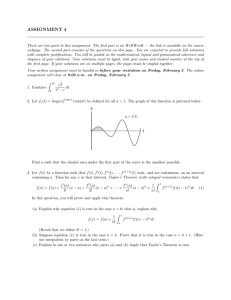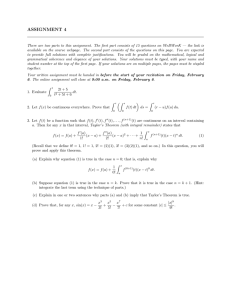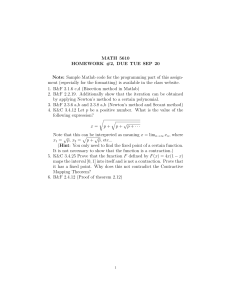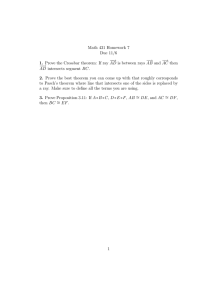18.034 PROBLEM SET 2
advertisement
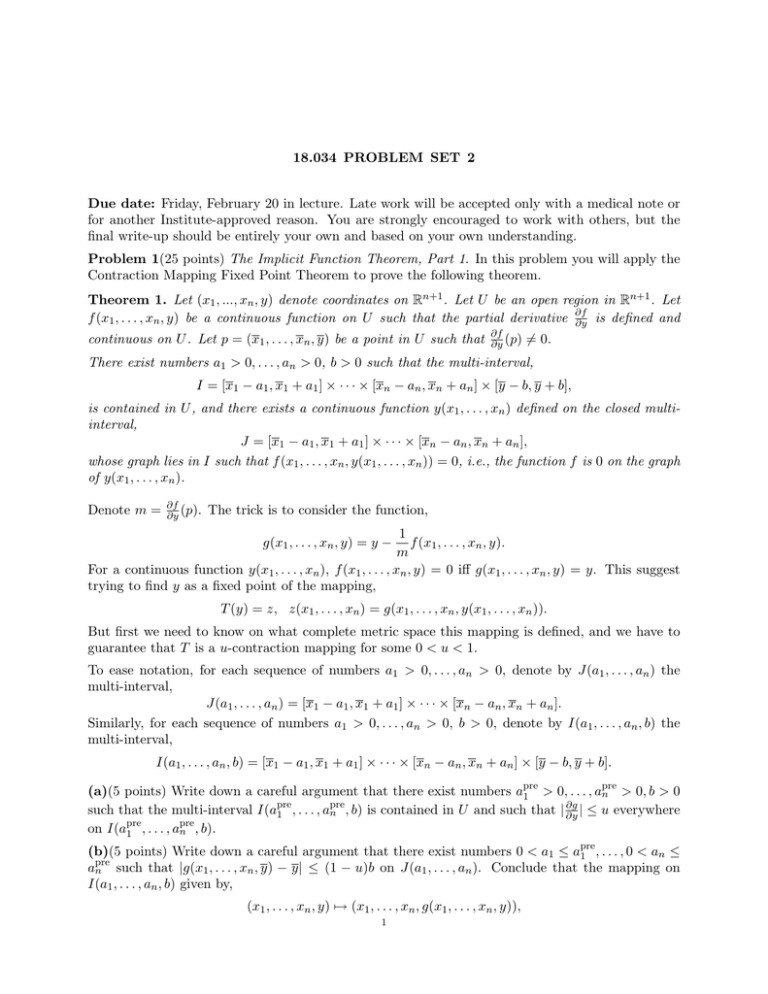
18.034 PROBLEM SET 2 Due date: Friday, February 20 in lecture. Late work will be accepted only with a medical note or for another Institute­approved reason. You are strongly encouraged to work with others, but the final write­up should be entirely your own and based on your own understanding. Problem 1(25 points) The Implicit Function Theorem, Part 1. In this problem you will apply the Contraction Mapping Fixed Point Theorem to prove the following theorem. Theorem 1. Let (x1 , ..., xn , y) denote coordinates on Rn+1 . Let U be an open region in Rn+1 . Let f (x1 , . . . , xn , y) be a continuous function on U such that the partial derivative ∂f ∂y is defined and continuous on U . Let p = (x1 , . . . , xn , y) be a point in U such that ∂f ∂y (p) � 0. = There exist numbers a1 > 0, . . . , an > 0, b > 0 such that the multi­interval, I = [x1 − a1 , x1 + a1 ] × · · · × [xn − an , xn + an ] × [y − b, y + b], is contained in U , and there exists a continuous function y(x1 , . . . , xn ) defined on the closed multi­ interval, J = [x1 − a1 , x1 + a1 ] × · · · × [xn − an , xn + an ], whose graph lies in I such that f (x1 , . . . , xn , y(x1 , . . . , xn )) = 0, i.e., the function f is 0 on the graph of y(x1 , . . . , xn ). Denote m = ∂f ∂y (p). The trick is to consider the function, 1 f (x1 , . . . , xn , y). m For a continuous function y(x1 , . . . , xn ), f (x1 , . . . , xn , y) = 0 iff g(x1 , . . . , xn , y) = y. This suggest trying to find y as a fixed point of the mapping, g(x1 , . . . , xn , y) = y − T (y) = z, z(x1 , . . . , xn ) = g(x1 , . . . , xn , y(x1 , . . . , xn )). But first we need to know on what complete metric space this mapping is defined, and we have to guarantee that T is a u­contraction mapping for some 0 < u < 1. To ease notation, for each sequence of numbers a1 > 0, . . . , an > 0, denote by J(a1 , . . . , an ) the multi­interval, J(a1 , . . . , an ) = [x1 − a1 , x1 + a1 ] × · · · × [xn − an , xn + an ]. Similarly, for each sequence of numbers a1 > 0, . . . , an > 0, b > 0, denote by I(a1 , . . . , an , b) the multi­interval, I(a1 , . . . , an , b) = [x1 − a1 , x1 + a1 ] × · · · × [xn − an , xn + an ] × [y − b, y + b]. pre (a)(5 points) Write down a careful argument that there exist numbers apre 1 > 0, . . . , an > 0, b > 0 pre pre ∂g such that the multi­interval I(a1 , . . . , an , b) is contained in U and such that | ∂y | ≤ u everywhere pre pre on I(a1 , . . . , an , b). (b)(5 points) Write down a careful argument that there exist numbers 0 < a1 ≤ apre 1 , . . . , 0 < an ≤ − y ≤ (1 − u)b on J(a , . . . , a ). Conclude that the mapping on apre such that | g(x , . . . , x , y) | n 1 n 1 n I(a1 , . . . , an , b) given by, (x1 , . . . , xn , y) �→ (x1 , . . . , xn , g(x1 , . . . , xn , y)), 1 maps I(a1 , . . . , an , b) back into itself. Therefore, if y(x1 , . . . , xn ) is a continuous function on J(a1 , . . . , an ) whose graph lies in I(a1 , . . . , an , b), then also the graph of z(x1 , . . . , xn ) = g(x1 , . . . , xn , y(x1 , . . . , xn )), lies in I(a1 , . . . , an , b). g(x1 , . . . , xn , y)| ≤ ub.) (Hint: Use the mean value theorem to prove that |g(x1 , . . . , xn , y) − (c)(5 points) Define B to be the metric space of continuous functions y on J(a1 , . . . , an ) whose graph lies in I(a1 , . . . , an , b) that satisfy y(x1 , . . . , xn ) = y. The metric is defined by, d(y1 , y2 ) = max |y1 (t) − y2 (t)|. t∈J Use the natural multi­dimensional generalization of the Cauchy Test to prove that this is a complete metric space. You need not prove the multi­dimensional generalization! Simply write down a careful statement of what you believe the generalization says, and apply this appropriately to deduce that B is a complete metric space. (d)(5 points) Prove that for each continuous function y in B, the following function z is also in B, z(x1 , . . . , xn ) = g(x1 , . . . , xn , y(x1 , . . . , xn )). Therefore the mapping T (y) = z is a mapping from B into itself. (e)(5 points) Prove that T is a u­contraction mapping. Use the Contraction Mapping Fixed Point Theorem to deduce that there exists a continuous function y in B such that T (y) = y. Deduce that f is 0 on the graph of y. (Hint: Use the mean value theorem.) Problem 2(5 points) The Implicit Function Theorem, Part II. The notation is from Problem 1. Let (x1 , . . . , xn , y) be a point in I such that f (x1 , . . . , xn , y) = 0. Prove that y = y(x1 , . . . , xn ). Therefore the points in I where f is 0 are exactly the points on the graph of y(x1 , . . . , xn ). (Hint: � y(x1 , . . . , xn ), use the mean value theorem to find a number y1 between y and y(x1 , . . . , xn ) If y = ∂g (x1 , . . . , xn , y1 ) gives a contradiction.) where the derivative ∂y Problem 3(10 points) Appendix A.1, Problem 1, p. 677. Problem 4(5 points) Section 2.4, Problem 16, p. 67 (just draw a rough sketch; the definition of “Step” is on the inside front cover of the text). Problem 5(5 points) Section 2.4, Problem 17, p. 67 (as above, just draw a rough sketch). 2

